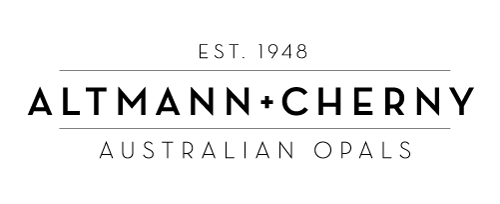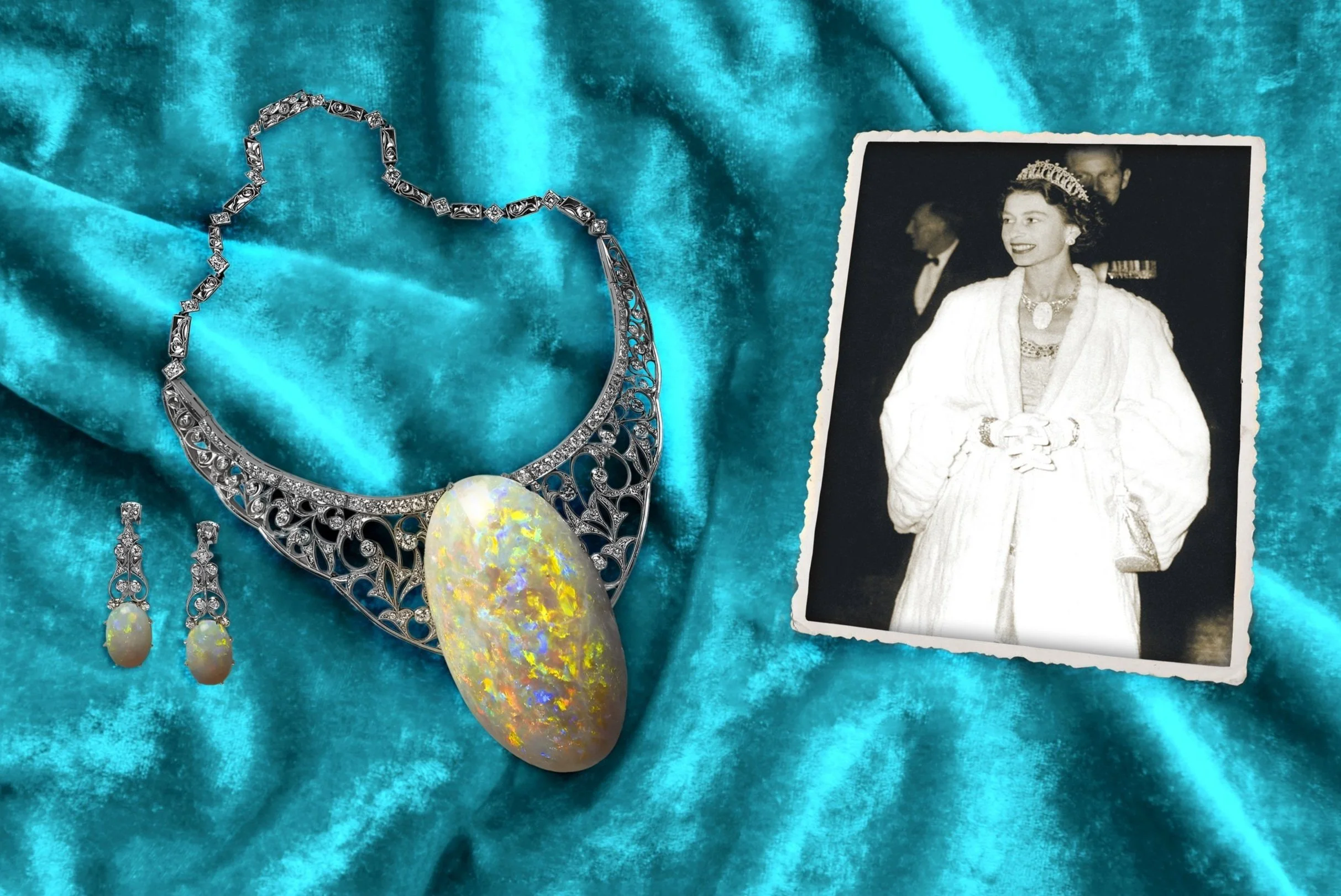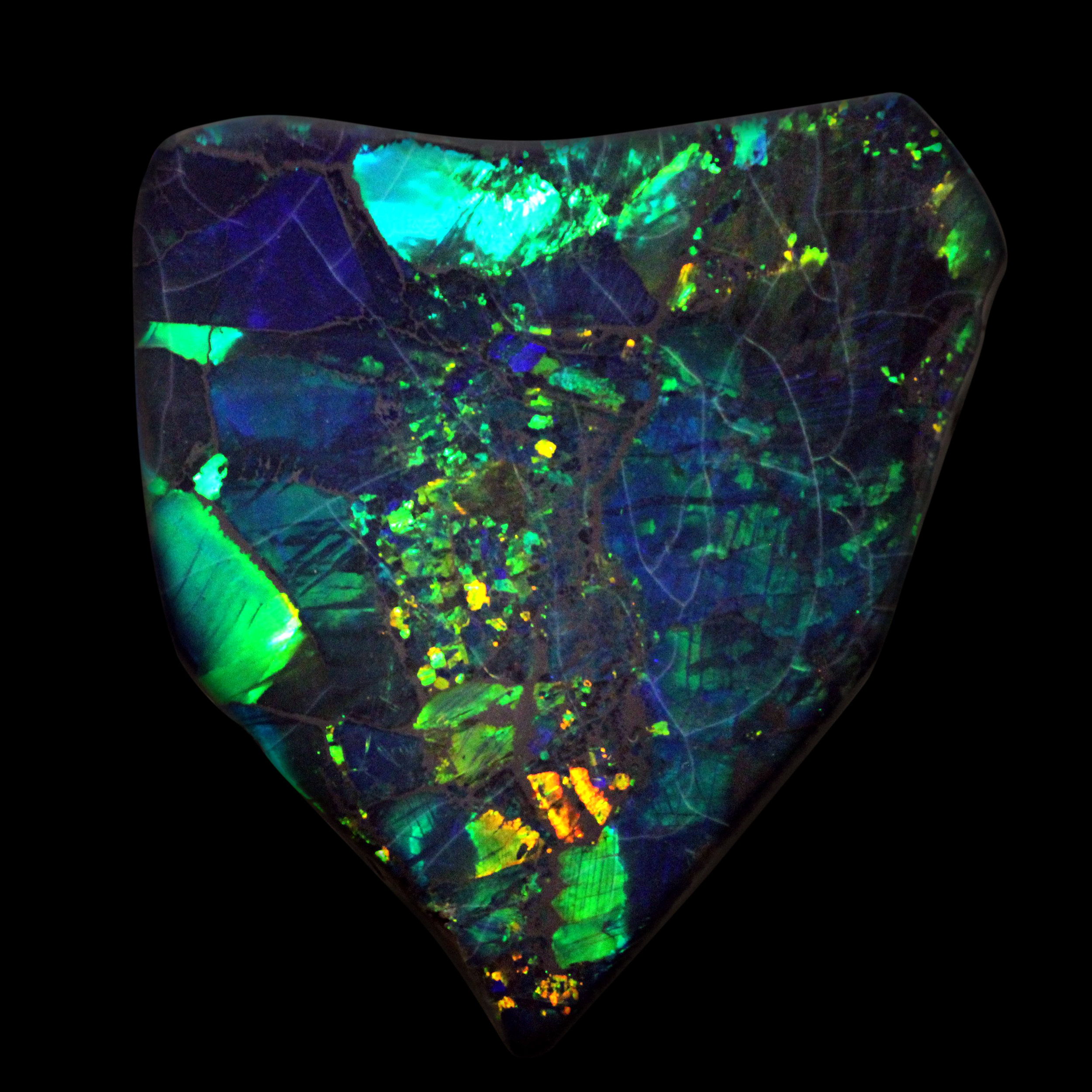FAMOUS OPALS
Since the 1840's the tenacious men and women of the outback have been digging the unyielding earth of the Australian opal fields hoping to find the elusive opal. For a few, luck came their way and some amazing opals were found which are now part of Opal folklore and renowned throughout the world.
“THE OLYMPIC AUSTRALIS”
As Opal buyers, John Altmann and Rudi Cherny both had an extraordinary talent for appraising a piece of rough opal and knowing exactly the quality of the opal which lay beneath the sandstone crust. In 1956 the company purchased a bag of rough Opal which had been mined at the Eight Mile Opal field, Coober Pedy, South Australia. Amongst all the uncut stones was one huge Opal. This Opal was so unique that John and Rudi decided not to cut the Opal but to keep it whole. They named the it “the Olympic Australis” in honour of the Olympic Games which were held in Melbourne that same year. This amazing Opal is 99% gem Opal, weighs 17,000 carats and is 11 inches long and 4.5 inches high. They submitted the Opal to the Guinness Book of Records and they declared it the largest and most valuable gem Opal ever found. Due to the purity of this extraordinary Opal, it was estimated that if it were to be cut it would make 10,000 1 carat stones at a wholesale value of US$180 per stone, making the total value of the Opal US$1,800,000.
“The Olympic Australis” is on permanent display at the Altmann + Cherny showroom, 18 Pitt Street, Sydney.
THE “AURORA AUSTRALIS”
The Aurora Australis was discovered at Lightning Ridge, New South Wales in 1938 and is believed to be the world’s most valuable Black Opal. Dug from an old sea-bed by Opal miner Charlie Dunstan it has the distinctive impression of a star fish on its back. “The Aurora Australis” displays a harlequin pattern with dominant red, green and blue colours against a black background. It weighs 180 carats and it measures 3 inches by 1.8 inches. The rarity of the Opal comes from its size and strong, vibrant colour play. Altmann + Cherny purchased the Opal in a semi-rough state, then cut and polished it into its brilliant oval shape. Realising what a true gem they had, they named it “The Aurora Australis “after the bright southern lights in the night sky. It is valued at $1,000,000.
“The Aurora Australis” is on permanent display at the Altmann + Cherny showroom, 18 Pitt Street, Sydney
“THE ANDAMOOKA OPAL” ALSO KNOWN AS “THE QUEEN’S OPAL”
Altmann + Cherny had become synonymous in the world of Australian Opal. As such in 1954 when the South Australian Government wanted to present Her Royal Highness, Queen Elizabeth II a gift in honour of her Royal visit to Australia they turned to Altmann + Cherny to find an Australian Opal of exceptional beauty and quality. The finest gem crystal Opal ever mined at the Andamooka Opal fields was selected and then John Altmann cut and polished this rare gem into 6 stones. The South Australian Government purchased 5 of these stones which were then made into a necklace, earrings and cufflinks. The Government presented this amazing suite of jewellery to HRH Queen Elizabeth II and HRH Prince Phillip during their Royal tour to Australia in 1954. “The Andamooka Opal” as the necklace became known was on display at Buckingham Palace in 2009, were Claire Altmann was fortunate to see these amazing Opals which her father had lovingly cut and polished 55 years previously. John Altmann always maintained it was the finest opal he had ever polished. The 6th opal cut from this incredible piece of rough Opal was sold to a private collector from Chicago, U.S.A.
THE SMITHSONIAN INSTITUTE, WASHINGTON D.C. USA
In 1953 John Altmann travelled to the USA for their first selling trip. He was invited by the Smithsonian Institution, in Washington D.C. to present his range of Australian Opals. The Institute’s most experienced gemstone specialists selected a diverse range of exceptionally fine gem Opals which were then included in their gemstone collection showcasing the gems of the world.
O T H E R F A M O U S O P A L S
THE BLACK PRINCE OPAL
"The Black Prince" originally known as 'Harlequin Prince', was found in 1915 at Phone Line by Urwin and Brown. Perhaps the least significant of the four notable stones from the same claim, this gem weighed 181 carats and displayed a flag pattern one side and the other was red.
This black opal was acquired in England by a wealthy American serviceman, and later donated to the New York Museum of Natural History. Later 'Prince' became part of the collection at Forest Lawn Memorial Cemetery, Los Angeles.
THE BUTTERFLY STONE OR RED ADMIRAL
"Butterfly Stone or the Red Admiral" was discovered during World War I on the 'Phone Line' field. Reported to be 51 carats, the stone is of extraordinary beauty, with a predominant red pattern equally visible from all angles. It wasn't until 1920 that the stone was given the name "Butterfly" because of its resemblance to the British butterfly, the Red Admiral.
THE FIRE QUEEN OPAL
"Fire Queen" was found in 1906 by Charlie Dunstan at the Angledool Diggings, Lightning Ridge. Weighing about 900 carats, the beautiful opal was sold by Dunstan for 100 pounds. The stone changed hands several times, and by 1928 it was in the Chicago Museum, valued at £40,000. In the 1940's, J.D. Rockefeller bought “The Fire Queen” for £75,000 and added it to his prestigious family gem collection.
THE PRIDE OF AUSTRALIA
“Pride of Australia" also known as "Red Emperor" Found in 1915 by Tom Urwin and Snowy Brown at Phone Line, Lightning Ridge. “The Pride of Australia” weighed 225 carats when cut and measured 2" x 3" opal. It has black and blue veins interlaced with brilliant red streaks. By 1954, it had toured at least five World Fairs as the greatest opal of Australia. Ernie Sherman bought ‘Pride of Australia' plus another three stones from the miners for £2000 around 1920. It was the highest price ever paid for four black opals.
In the 1950s “The Pride of Australia” was sold to Dr. Hubert Eaton, the President and Founder of the Forest Lawn Memorial Park in Glendale, CA, USA for a reputed £150,000.
HALLEY'S COMET
“Halley's Comet” is recorded in the Guinness Book of Records as the world's largest uncut black opal nobby. The massive stone was found by a group of opal miners on the Leaning Tree Claim at Lightning Ridge known as "The Lunatic Hill Syndicate" around the time "Halley’s Comet" appeared in Australian skies. It weighs 1982.5 carats and measures 100 x 66 x 63 mm. “Halley's Comet” was for sale in 2005 for AUD$1.2 million.
THE VIRGIN RAINBOW
Considered to be one of the world's most beautiful opals, "The Virgin Rainbow" is a 63.3mm Black Crystal Opal Belemnite Fossil in a 'pipe' shape. It Features gem quality colour, and is also said to glow in the dark. The Virgin Rainbow weighs in at 72.65 carats, and was discovered at Three Mile Fields, Coober Pedy, South Australia, September 2003 John Dunstan.
ERIC THE PLIOSAUR
One of the more interesting fossil discoveries in the past few decades — 'Eric' the Pliosaur — features a a number of unique qualities. During the fossilization process, opalisation occurred, leaving the fossil with a semi-precious sheen. This is not the most interesting aspect of the fossil, however, as that may very well be the tale of the its discovery, reconstruction, and ownership changes that rescued the fossil from being made into jewelry and found it a permanent home within an Australian museum.











